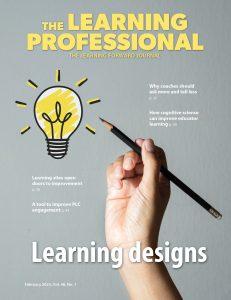The Redesign PD Community of Practice engages teams from 22 of the nation’s leading school districts and charter management organizations in identifying local professional learning challenges and creating scalable solutions. Learning Forward facilitates the community, where teams participate in continuous learning cycles to improve how they manage their professional learning systems.
As they focus on measuring the impact of professional learning, the members of the Lake County, Florida, team participating in the Redesign PD Community of Practice are beginning to see evidence that professional learning, designed in partnership with teachers, can lead to improvements in student learning. Here’s how they got there.
After attending a summer training on how to teach math using a more problem-based approach, Dawn Elliott began to see improvements in her 3rd graders’ skills. By using base 10 blocks, they’ve grown stronger in adding and subtracting with regrouping across place values up to the thousands.
But Elliott, who teaches at Astatula Elementary in Lake County Schools, isn’t the only teacher seeing growth in students’ math skills. As a teacher leader, she also leads professional learning on how to create meaningful tasks using multiple resources and increase “academic student talk and engagement in the classroom.”
Andrea Pyatt, the district’s Innovative Professional Development (iPD) facilitator, attributes the progress to changes in the way teachers experience professional learning related to math.
As one of 22 districts participating in the Redesign PD Community of Practice, facilitated by Learning Forward, Lake County Schools is learning the importance of redesigning professional learning in partnership with teachers.
When Pyatt stepped in to the role of iPD facilitator in early 2015, she reviewed student data and saw low performance in math across the district. Coming from a background in health care, where she was a clinical scientist, she didn’t want to just roll out a new professional development program without improving the overall professional learning system. “You can’t just randomly throw PD to teachers and expect it to change the system,” she says.
She also wanted the process to be led by teachers and informed by their feedback. So she created a math team with middle and high school teachers, administrators, and district-level math specialists across all grade levels.
“I wanted it to come from the team and not from me,” she says. Through their conversations, team members shared that because the new standards require more advanced math skills in lower grades, many teachers felt they didn’t have the skills and expertise they needed to teach the content.
“This team really stepped up and told me what they needed,” Pyatt says. “I’m glad that we had these conversations because they were very open and honest with me and we learned together.”
The program specialist at the secondary level, who has since moved to a state-level position, designed an in-person content training for teachers in which she presented them with a math task and challenged them to work with other teachers to solve it. Through the process, they learned other ways to approach the problems and strategies they could use with their own students.
“She used her direct teaching to show that you don’t have to start at the front of the board and teach the old way,” Pyatt says.
During the 2015-16 school year, middle school teachers as well as algebra 1 and geometry teachers participated in the sessions. But Pyatt says she knew teachers at the elementary level also needed this support. This school year, content sessions were added for 1st, 3rd, and 5th grades, as well as algebra 2 at the high school level.
Participating teachers complete a survey that measures their initial reactions to the sessions, which is in keeping with level 1 of University of Kentucky Professor Thomas Guskey’s five-level framework for measuring the effectiveness of professional learning. To measure level 2 — the knowledge and skills they have acquired — they also complete a follow-up survey about a week later.
In addition to the content training, the district also began working with Math Solutions to implement a lesson study process. Consultants partner with classroom teachers in 4th and 8th grade and algebra 1 classes to teach lessons to students and then reflect on how it worked. Working with the consultants, Pyatt says, has “expanded their thinking of what’s possible.”
Now Pyatt and her team are seeing evidence that both professional learning opportunities are making a positive difference, particularly at the elementary level.
“We frequently hear from teachers that their students have more passion for mathematics. They enjoy math!” says Melissa Carli, a 3rd-to-5th-grade math program specialist. “Teachers also report students developing a more conceptual understanding of the mathematics as opposed to just replicating procedures.”
A recent analysis of midyear scores on the i-Ready assessment — a Florida Standards-aligned tool that helps teachers monitor their students’ progress and plan instruction — shows that in 5th grade, students whose teachers participated in the professional learning sessions averaged two points more growth than those whose teachers didn’t participate. In 1st and 3rd grade, the gain was an additional point over the district’s average growth.
Math program specialists are also collecting classroom walk-through data, which addresses Guskey’s level 4 — the application of new knowledge skills. The specialists also use this process to measure level 3 — whether teachers have the support they need at their schools to implement the practices. The specialists are beginning to see evidence of teachers’ learning, and a major part of their feedback is validating and affirming teachers’ use of various teaching strategies. When they don’t see specific practices in use, they offer additional support.
The math team has now grown from 18 to 30 people since it was formed and plans to continue providing math support to teachers through both content training and lesson study cycles. The overall effort to redesign professional learning has also contributed to a stronger partnership between the professional development and curriculum departments.
Pyatt adds that, throughout this process, she has valued the support and feedback from the members of the Redesign PD Community of Practice.
“I feel like they are my partner in this work. I’ve been able to talk through this plan, and they push back,” she says. “It’s always around the cycle of learning so that I’m learning to inform what the next step is going to be.”
This post originally appeared in Learning Forward’s PD Watch.







